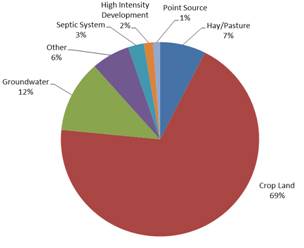Healthy Waters Program
Restoration Targets
Bringing Back the Nottawasaga – From Brook to Bay
The Nottawasaga Watershed covers 3,700 square kilometres. The valley contains diverse features and ecosystems.
The Nottawasaga River begins at the junction of the Niagara Escarpment and the Oak Ridges Moraine. The river meanders down through the internationally significant Minesing Wetlands and out into Georgian Bay at Wasaga Beach, the world’s longest freshwater beach!
There are proven environmental, economic, social and health benefits to protecting our lakes, rivers and groundwater. Meeting and exceeding the watershed restoration targets will help safeguard these benefits.
Watershed Restoration Targets
The NVCA’s monitoring of water quality and natural habitat in the Nottawasaga Valley watersheds indicates that many of our river systems have been impaired, and critical habitat and functions lost. But with your help, much can be done.
About 95% of the land in the Nottawasaga Watersheds is privately owned. Achieving water quality and habitat targets will depend on everyone working in concert. Our stewardship programs assist landowners that want to protect and conserve our common waters.
Targets:
- Over 75% of streams with a naturally vegetated cover (30m wide)
- Over 10% wetlands
- Over 30% in Forest Cover
- Over 10% Interior Forest Cover (>100m from the edge)
- Meet or exceed Provincial Water Quality Objectives:
- average total phosphorus (TP) less than 0.03mg/L
- TP load of less than 36,334 kg/year
- E. coli less than 100cfu/100mL (Ontario recreational limit)
- total suspended solids (TSS) less than 25mg/L during baseflow
Our watershed management plan and stream monitoring programs inform our restoration priorities and targets. The document below summarizes the targets for several subwatersheds in the Nottawasaga Valley.
Nottawasaga Valley Watershed Phosphorous Sources
Every year about 47 tonnes of phosphorus enters the Nottawasaga River.
Phosphorus is a nutrient that encourages plant growth. Each 1kg of phosphorus can produce 300-500 kg of algae. Excessive concentrations can result in algal blooms. Certain species of algae can produce toxins. Additionally, when the blooms die, they consume oxygen which impacts aquatic life.
Phosphorus comes from agricultural runoff from croplands and pasture, urban runoff from lawns and gardens, failing septic systems, and sewage treatment plant effluent.
